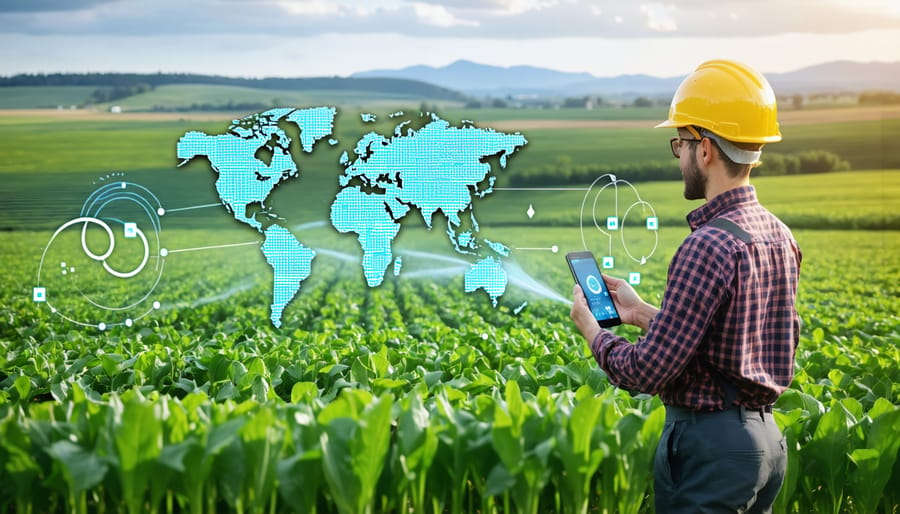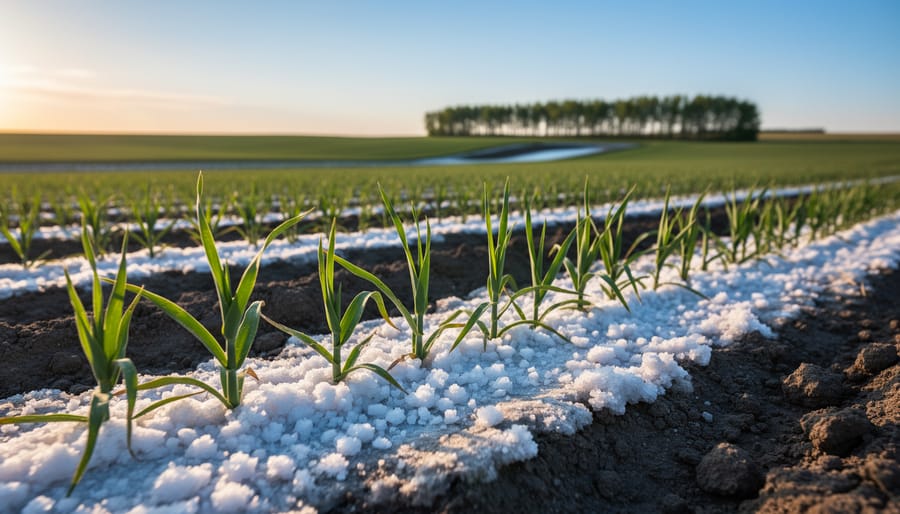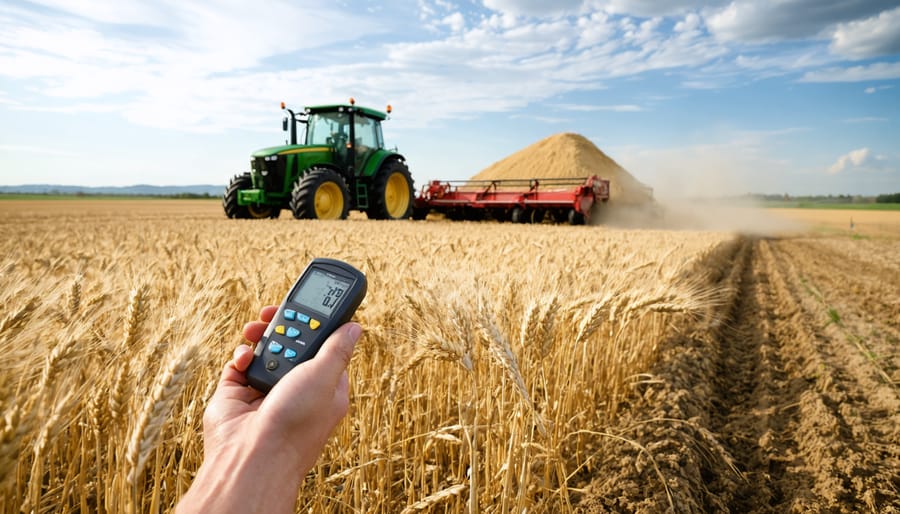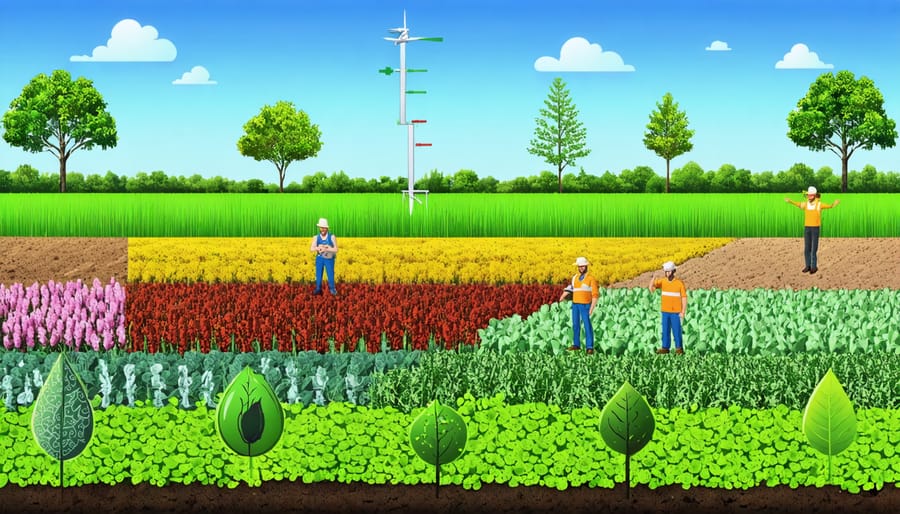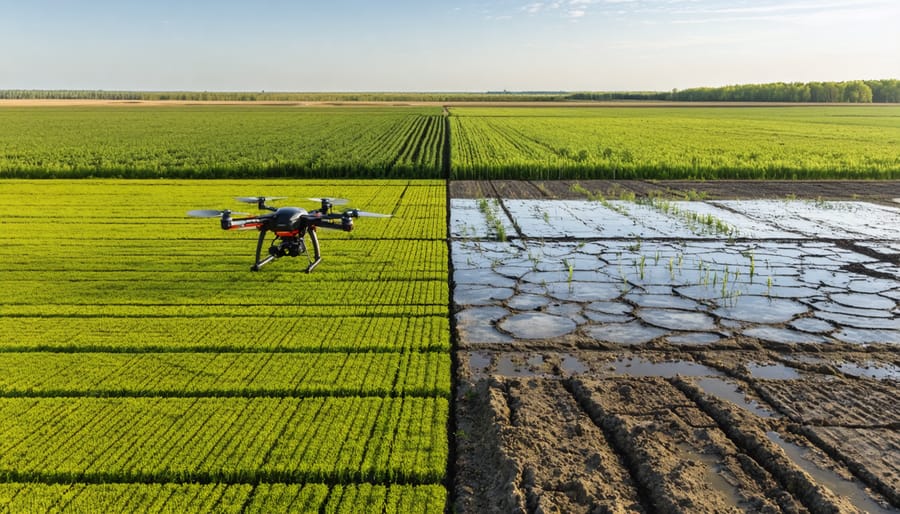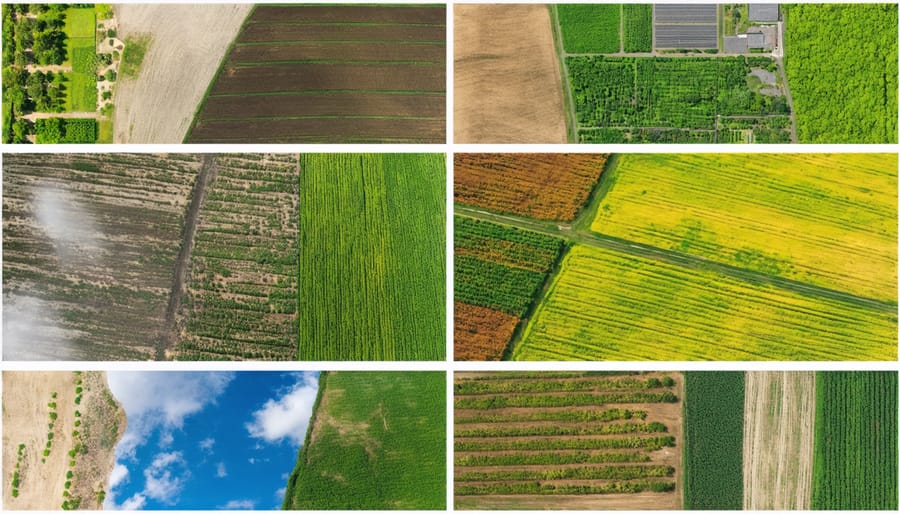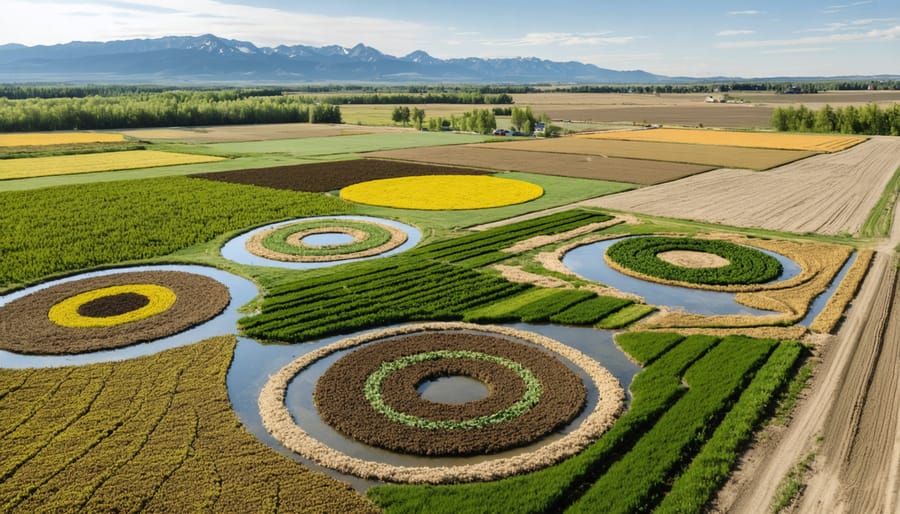Water technology innovation stands at the forefront of Alberta’s agricultural revolution, transforming how farmers manage their most precious resource. From precision irrigation systems that reduce water consumption by up to 40% to AI-powered soil moisture sensors delivering real-time data to smartphones, these breakthrough solutions are reshaping Prairie agriculture. Leading Alberta producers have already integrated smart water management systems across 2.3 million hectares, resulting in documented yield increases of 15-30% while conserving vital groundwater resources.
The convergence of drought-resistant farming practices and cutting-edge water monitoring technology offers Prairie producers unprecedented control over their irrigation systems. Advanced soil moisture mapping, coupled with automated precision sprinklers, now enables farmers to deliver exactly the right amount of water to each field section based on real-time conditions. These innovations prove particularly crucial as Alberta faces increasing climate variability and growing pressure to optimize water usage across its 4.8 million hectares of irrigated farmland.
For Alberta’s agricultural community, embracing these water technologies isn’t just about conservation – it’s about building resilient farming operations that can thrive despite challenging conditions. The latest field trials demonstrate that farms implementing these systems recover their investment within 2-3 growing seasons through reduced input costs and improved crop quality.
Precision Irrigation Systems Taking Root in Alberta
Soil Moisture Sensors and Real-time Monitoring
Modern soil moisture sensors are revolutionizing how Alberta’s dry climate farming operations manage water resources. These smart devices provide real-time data about soil moisture levels at various depths, helping farmers make precise irrigation decisions that save both water and money.
The most common sensors used in our region include Time Domain Reflectometry (TDR) probes and capacitance sensors, which can be installed at multiple soil depths from 10 to 100 centimetres. These sensors transmit data directly to smartphones or computer systems, allowing farmers to monitor moisture levels from anywhere on the farm.
Local farmer Mike Thompson from Lethbridge shares, “Since installing moisture sensors across my canola fields, I’ve reduced water usage by 30% while maintaining optimal crop health. The real-time alerts help me know exactly when to irrigate.”
The data collected through these sensors also helps identify soil moisture patterns throughout the growing season. This information is particularly valuable for planning irrigation schedules and understanding how different crops respond to varying moisture levels. Many producers are now combining sensor data with weather forecasts to make even more informed decisions.
For best results, experts recommend installing sensors in multiple locations across fields, considering soil type variations and topography. The initial investment typically ranges from $500 to $2,000 per sensor system, but the water savings and yield improvements often provide returns within two growing seasons.
Variable Rate Irrigation Systems
Variable rate irrigation (VRI) systems represent a significant leap forward in precision agriculture, allowing farmers to apply water with unprecedented accuracy across their fields. These smart systems use a combination of soil moisture sensors, weather data, and GPS technology to create detailed irrigation maps that adjust water application rates based on specific field conditions.
Here in Alberta, where water conservation is crucial, VRI systems have shown impressive results. Local farmer Dave Thompson from Lethbridge County reports a 30% reduction in water usage while maintaining optimal crop yields after implementing VRI technology on his 800-hectare operation.
The system works by dividing fields into management zones, each receiving precisely the amount of water needed. Factors like soil type, topography, and crop requirements determine these zones. Modern VRI systems can even adjust irrigation rates in real-time based on current field conditions, ensuring no area receives too much or too little water.
Key benefits include:
– Reduced water waste and pumping costs
– Better crop uniformity
– Decreased risk of nutrient leaching
– Lower energy consumption
– Improved yield in previously challenging field areas
While the initial investment ranges from $15,000 to $50,000 depending on field size and system complexity, many Alberta farmers find the return on investment occurs within 2-3 growing seasons through water and energy savings alone. Provincial programs often offer cost-sharing opportunities for farmers interested in adopting this technology.
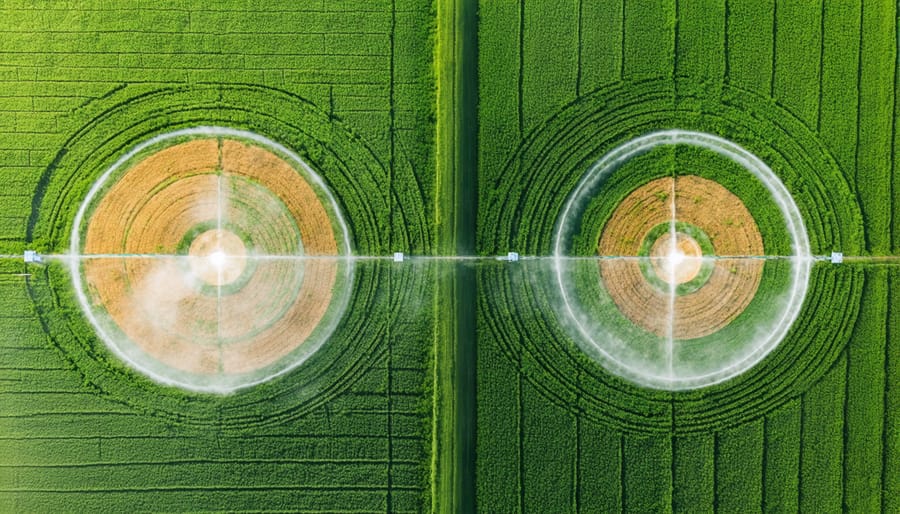
Water Recycling Solutions for Better Soil Management
Grey Water Systems for Agriculture
Grey water systems are transforming how Alberta farmers manage their water resources, offering a sustainable solution that complements existing natural water filtration systems. These systems capture and treat water from various farm operations, including equipment washing stations, dairy parlours, and produce processing facilities.
A typical agricultural grey water system can recycle up to 70% of farm operational water, significantly reducing the strain on local water sources. For example, the Morrison Family Farm in Red Deer County implemented a grey water system in 2021, cutting their annual water consumption by 45,000 litres while maintaining optimal crop irrigation.
The treatment process typically involves a three-stage system: primary filtration to remove solid particles, biological treatment using beneficial bacteria, and final UV sterilization. This treated water is particularly valuable for non-food crops and greenhouse operations, where water quality requirements are less stringent than for direct crop application.
Local success stories include the Sundre Community Farm, where a grey water system helped reduce water costs by 60% in their first year. Their system integrates seamlessly with existing irrigation infrastructure and requires minimal maintenance – typically just quarterly filter changes and annual system checks.
For farmers considering implementation, Alberta Agriculture offers cost-sharing programs covering up to 30% of installation costs. The initial investment typically ranges from $15,000 to $40,000, with most systems paying for themselves within 3-5 years through reduced water bills and improved resource efficiency.
Nutrient Recovery Technology
Modern farming practices are discovering the hidden value in what was once considered waste water. Nutrient recovery systems are revolutionizing how we manage water resources by extracting valuable nutrients like nitrogen, phosphorus, and potassium from agricultural runoff and processing water. These systems not only improve water infiltration but also create a circular economy within farm operations.
In Alberta, several pioneering farms have implemented struvite crystallization technology, which captures phosphorus and nitrogen in a form that can be reused as fertilizer. For example, the Morrison Family Farm near Lacombe reported a 30% reduction in fertilizer costs after installing a nutrient recovery system, while simultaneously reducing their environmental impact.
The process typically involves three main stages: separation of solids, nutrient extraction through chemical or biological processes, and conversion into usable fertilizer products. These systems can recover up to 90% of phosphorus and 40% of nitrogen from waste streams, creating a valuable resource from what would otherwise be a disposal challenge.
Local success stories include the Brooks Greenhouse operation, which implemented an ion exchange system that recovers nutrients from hydroponic drainage water. Their system processes 50,000 litres of water daily, recovering nutrients worth approximately $15,000 annually while reducing their environmental footprint.
For smaller operations, simplified nutrient capture systems using constructed wetlands and biofilters offer a more accessible entry point to nutrient recovery technology, proving that solutions exist for operations of all sizes.
Soil Health Monitoring Tools
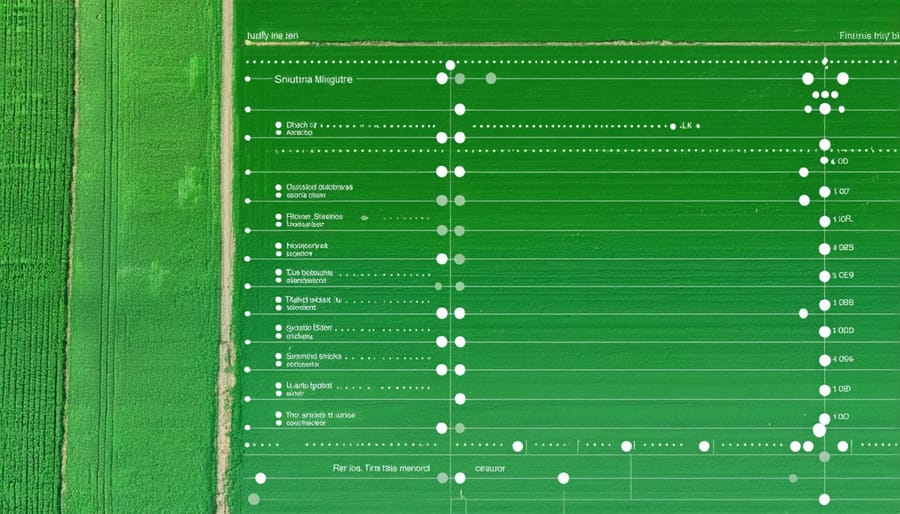
Digital Soil Mapping
Digital soil mapping has revolutionized how Alberta farmers understand and manage their soil health. Using a combination of satellite imagery, ground sensors, and advanced GPS technology, these mapping systems create detailed, real-time visualizations of soil conditions across entire fields.
Modern soil mapping tools can measure crucial factors like moisture content, organic matter levels, and nutrient distribution with unprecedented accuracy. Farmers can view these detailed maps through user-friendly mobile apps or desktop interfaces, allowing them to make informed decisions about irrigation scheduling and resource allocation.
In the Lethbridge region, precision agriculture specialist Sarah Thompson has seen firsthand how digital soil mapping helps farmers optimize water use. “We’re seeing water savings of up to 30% when farmers use these maps to guide their irrigation decisions,” she notes. The technology combines data from multiple sources, including electromagnetic sensors that measure soil electrical conductivity and moisture probes that track water movement through different soil layers.
The benefits extend beyond water conservation. By understanding soil variability across their fields, farmers can implement targeted irrigation strategies that improve crop uniformity and reduce the risk of both under and over-watering. This precision approach also helps prevent nutrient leaching and promotes better root development, leading to healthier crops and more sustainable farming practices.
Many Alberta agricultural services now offer soil mapping consultations, making this technology increasingly accessible to farms of all sizes.
Water Retention Analysis Tools
Modern water retention analysis tools have revolutionized how Alberta farmers measure and understand their soil’s water-holding capacity. The most widely adopted tool is the Time Domain Reflectometry (TDR) probe, which uses electromagnetic waves to provide instant moisture readings at various soil depths. Many local producers have found success with portable moisture meters, which offer quick field assessments during critical growing periods.
Digital soil mapping systems, combined with moisture sensors, create detailed water retention maps that help farmers identify areas needing attention. These systems typically include weather stations that track rainfall and evaporation rates, providing a comprehensive view of water movement through the soil profile.
Manitoba-based farmer Tom Peterson shares, “Since implementing moisture monitoring tools, we’ve reduced irrigation costs by 30% while maintaining optimal soil moisture levels.” This experience reflects a growing trend among Prairie farmers who are using data-driven approaches to water management.
Laboratory analysis kits are also available for more detailed soil water retention curves. These affordable tests help farmers understand how different soil types on their land hold water at various tensions, leading to more precise irrigation scheduling.
The Alberta Agriculture Department offers workshops on using these tools effectively, with hands-on training sessions available throughout the growing season. Many agricultural extension offices loan out basic moisture monitoring equipment, making it easier for farmers to try before investing in their own systems.
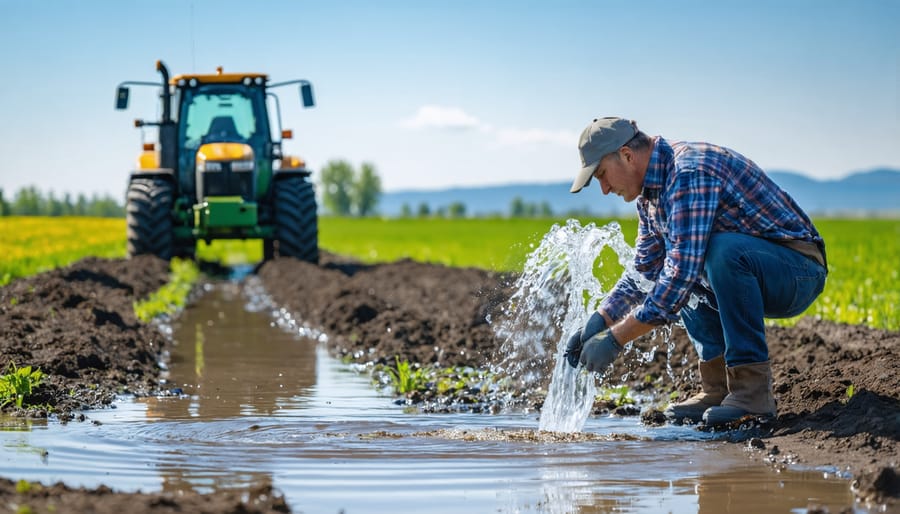
Real Alberta Success Stories
Meet Tom and Sarah Peterson, who transformed their 800-hectare farm near Lethbridge with smart irrigation technology. After installing soil moisture sensors and a variable-rate irrigation system in 2021, they reduced water usage by 30% while maintaining crop yields. “The sensors tell us exactly when and where to water, taking the guesswork out of irrigation,” Sarah explains.
In the Peace River region, Marcus Wong’s innovative approach to water management has become a model for other farmers. By implementing a combination of precision irrigation and water recycling systems, his vegetable operation now uses 40% less water than five years ago. “We capture and reuse about 75% of our irrigation runoff,” Marcus shares. “The return on investment was realized within two growing seasons.”
The Blackfoot First Nation’s community farm near Gleichen showcases how traditional knowledge and modern technology can work together. Their drip irrigation system, integrated with weather monitoring stations, has helped them achieve remarkable water efficiency in their traditional Three Sisters garden while preserving cultural growing practices.
Near Red Deer, the Johnson Family Farm’s story demonstrates the power of collaboration. Working with local agricultural extension services, they installed a state-of-the-art subsurface drip irrigation system. “We’ve cut our water consumption by half and increased our corn yields by 25%,” says Dave Johnson. Their success has inspired neighboring farms to adopt similar technologies.
The Mountain View Colony near Cardston proves that large-scale operations can successfully transition to water-smart technologies. Their 2,000-hectare operation uses soil moisture mapping and automated irrigation scheduling, resulting in a 35% reduction in water use across their diverse crop rotation.
These success stories share common elements: careful planning, willingness to learn, and support from local agricultural experts. Each farm started with a small trial area before expanding their water-smart systems, making the transition more manageable and cost-effective. Their experiences show that innovative water technologies aren’t just about conservation – they’re about building more resilient and profitable farming operations for Alberta’s future.
As we’ve explored throughout this article, innovative water technologies are revolutionizing agricultural practices across Alberta, offering promising solutions for sustainable farming. The integration of precision irrigation systems, soil moisture sensors, and smart water management tools has already demonstrated significant benefits, with many farmers reporting water savings of 20-30% while maintaining or improving crop yields.
Looking ahead, the future of water management in Alberta appears increasingly bright. With ongoing technological advancements and growing adoption rates among local farmers, we’re seeing a shift towards more resilient and efficient agricultural practices. The combination of traditional farming wisdom with modern technology is creating a pathway for sustainable water use that benefits both agricultural productivity and environmental conservation.
The success stories from various regions in Alberta demonstrate that these technologies are not just theoretical solutions but practical tools that deliver real results. From the drought-resistant areas of Southern Alberta to the diverse farming operations in the central region, farmers are proving that innovative water management can work in various contexts and scales.
As our climate continues to change and water resources become more precious, these technologies will play an increasingly vital role in maintaining Alberta’s agricultural prosperity. The investment in water management technology today is an investment in the future of farming, ensuring that our agricultural communities remain strong and sustainable for generations to come.

